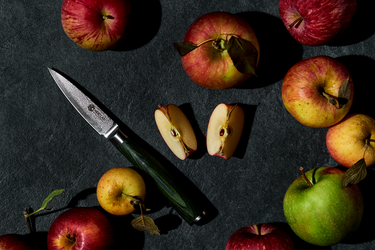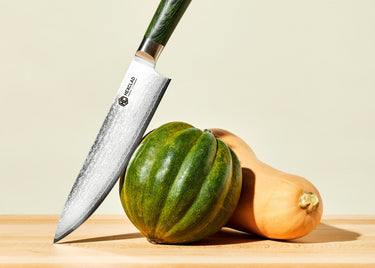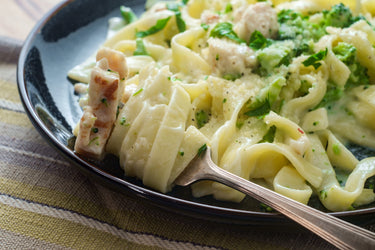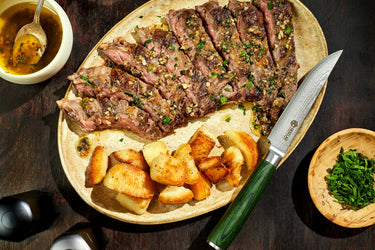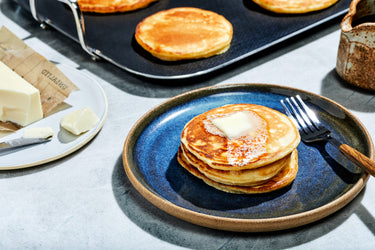How To Clean Non-Stick Pans Properly: Burnt, Baked & More
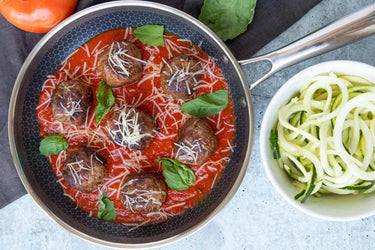
What's more annoying than having to wash your dishes after a meal? The grueling thought that grime and dirt might not come off when you wash them. Thankfully, non-stick pans can be a dream to clean — that is, if you buy the right pan and know how to do the job right.
Whether charred or succumbed to grime build-up, non-stick pans should always be maintained and cleaned. Neglecting to do this can result in less flavorful meals. No one wants food served from a burnt or ruined pan. Luckily, there are ways to avoid this and have pan maintenance become a hassle-free routine.
Here at HexClad, we specialize in innovative materials to create our high-quality cookware. That’s why our non-stick pans don’t require tedious, time-consuming care after you use them — we know you have better things to do.
Still, we also know the importance of cleaning kitchenware, especially when your non-stick pan is due for some much-needed TLC. Today, we’re going over how to clean and maintain your non-stick pan and the dos and don'ts of non-stick pan upkeep.
Why Is It Important to Clean Your Non-Stick Pan?
Think of a non-stick pan as your cooking secret weapon. When dealing with delicate foods like fish, eggs, or a savory stir-fry meal, this specific piece of cookware is ideal for easy cleanup. The purpose of having a non-stick pan is to have minimal-to-no residue left on the pan itself.
Neglecting to clean your non-stick pan thoroughly affects how you cook: It will reduce the quality of what you cook, and mealtime cleanup will be harder if build-up develops. Lack of cleaning can make your meals unappetizing, and it’s a kitchen don’t that can easily be avoided (especially with easy-to-clean options like HexClad’s non-stick pan).
When you work with your non-stick pan, it works with you. Over time, this versatile piece will become your go-to for everything from omelets to reduction — don’t self-sabotage by leaving your pan in the lurch.
Do's and Don'ts of Cleaning Your Non-Stick Pan
Cleaning your non-stick pan takes more than sponges, water, and dish soap to restore it to its former glory. Here are a few dos and don'ts of cleaning your non-stick pan.
The Dos of Cleaning Your Non-Stick Pan
Caring for your non-stick pan doesn’t have to be a Herculean task. There are a couple of ways you can get your go-to pan looking perfect ASAP. Some easy solutions for cleaning your pan include:
- Seasoning your pan to help strengthen the cleaning process. This consists of warming your pan, dabbing the pan in just the right amount of oil, then wiping off the excess. Seasoning your pan is generally done with cast iron skillets, but it is just as effective for non-stick pans.
- Simmering food stuck on your pan helps make cleaning easier as it quickly removes any food residue left on it. You have to place the non-stick pan atop your stove, fill it with water, and let it simmer. After a while, the food should start to soften or float upwards.
- Choose your cooking pan wisely. Non-stick pans are used if you do not want your food or its juices sticking to the surface. Non-stick pans are not all-purpose, so maybe shelve them if you’re sautéeing.
The Don'ts of Cleaning Your Non-Stick Pan
Even though cleaning your non-stick pan isn't all that intimidating, there are factors to keep in mind. A couple of things to avoid when cleaning your pan include:
- Do not use non-stick cooking sprays on your pan. Spraying on any non-stick surface can lead to build-up that would affect your cooking by creating a barrier between the pan and the food itself. Also, it will start to develop a layer of stickiness.
- Always use hot water instead of cold water. The sudden temperature change can cause the non-stick pan's metal to distort drastically. It will cook food unevenly, shake as it's on the stovetop, and cause the oil to fall to the side.
- Do not use metal utensils on non-stick pans. They’re non-stick pans that are metal utensil friendly, but that depends on your cookware brand. Non-stick coatings are sensitive and are scratched and wear down quickly. So, metal against metal may not be the soundest idea for handling non-stick pans. It will definitely lead to potential damage to the surface of the pan.
How Do I Clean a Non-Stick Pan?
To clean your non-stick pan, all you need is a sponge, dish soap, warm water, and white vinegar. Let’s get into it:
Discard the Contents of Your Pan
Before getting started, make sure that you do not leave any food scrap or oils with a silicone or wooden spatula. Always dispose of scraps or oil in the waste bin instead of the sink drain.
Rinse With Hot Water
Afterward, rinse your non-stick pan in hot water, causing the remaining oil and food scraps to break down. If you have a lot of food scraps, use a slotted spoon or a sieve to prevent them from going into your sink drain.
Getting Rid of Oil Residue From the Pan
Apply a 1/2 mug of white vinegar into the pan, then add hot water until it’s about 2/3rds full. Once you have filled the pan, turn on the stove and let the liquid simmer for five minutes.
Turn off the stove and place a paper towel in the pan to soak in the remaining residue and caked-on grease. You can also sponge it off. If most of the residue absorbs into the paper towel, you can dispose of it in the trash.
Soak, Rinse, and Dry Your Non-Stick Pan
Fill up your sink with hot water and soap, then place the pan into it. This will help to release any remaining residue. Now and then, change the oily water. Once the pan finishes soaking, rinse the soapy water off and dry it with a paper towel.
How Can I Clean a Burnt Non-Stick Pan?
Removing the burnt residue off your pan is a similar process. However, baking soda is required. Mix baking soda and water until it becomes a paste, then spread it onto the burnt surfaces. After half an hour, you can wipe off the baking soda solution.
What’s the Best Way To Clean a HexClad Pan?
HexClad’s pans are hybrid cookware, meaning they’re not quite as easy to clean as non-stick pans. Unlike typical non-stick pans, HexClad’s hybrid tech lasts longer and is way more durable. We’ll take that trade-off any day.
This cookware provides of the benefits of stainless steel with an added non-stick coating that allows for even easier clean-up than traditional stainless steel pans. These pans are also dishwasher safe — so most of the time, clean up is still the easiest part of your meal prep process. You can also clean HexClad pans using warm soapy water to remove cooking residue and light stains.
Still, HexClad’s stainless steel may require more abrasive sponges and effort after cooking something like a steak or veggies on high heat. If you’re dealing with heavy-duty stains, let your pans soak in warm soapy water for between 10 and 15 minutes. After a good soak, these stains should lift when scrubbed.
What’s the Best Non-Stick Pan?
The best non-stick pan isn’t really a non-stick pan at all. When it’s time to choose the perfect non-stick pan for your kitchen, look no further than HexClad’s hybrid pans. These pans are set apart by a few key technological innovations that combine the best of stainless steel and non-stick pans:
A Laser-Etched Non-Stick Pan
This technology gives the surface of your pan a unique pattern of peaks and valleys. Those peaks give your dishes the perfect sear and prevent flaking and peeling, while the valleys help prevent sticking.
Compatible With All Cooking Surfaces
Thanks to a tri-ply design, your HexClad pan is compatible with both magnetic induction cooktops and standard gas or electric stoves. That’s because the outermost layer of each pan is magnetic stainless steel.
Compatible With Metal Utensils
In addition, HexClad pans are metal utentil-safe, allowing for up to 500 degrees of heat exposure and easy cleaning in the dishwasher.
Handle Stays Cool
With HexClad pans, you never have to worry about burning your hand on a hot handle. Thanks to our proprietary heat-resistant tech, you can cook with any temperature and keep your pan’s handle cool.
A Dream to Clean
It's not hard to give your non-stick or HexClad pan some much-needed maintenance. HexClad’s hybrid tech does require extra time to thoroughly clean, but this is beneficial and gives you a more pristine pan. We hope this guide helped you with cleaning and caring for your non-stick pan — and showed you why HexClad’s durable and long-lasting pans are a better choice as the best of both the stainless steel and non-stick worlds.
If you want to kick your cooking up a notch, check out HexClad’s small-but-mighty 8-inch non-stick pan. This easy-to-clean and dishwasher-safe pan takes the guesswork out of cleaning — and its hybrid versatility gets any job done. Learn more about this chef’s secret weapon on our website today.
Sources:
The Science of Nonstick Cookware | FineCooking
